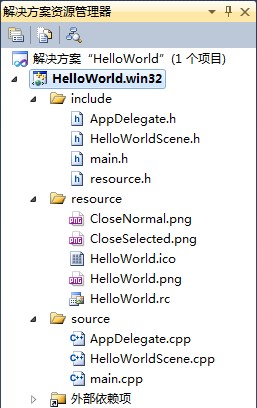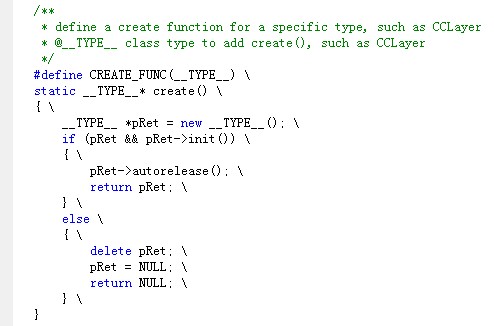搭建好环境之后的第一件事,就是如何在搭建好的环境下运行我们的第一个程序HelloWorld。下面来剖析一下HelloWorld。
本人菜鸟,只想把学到的跟大家分享,有错请指出交流,不喜勿喷。
剖析之前需先掌握引擎的基本知识,这里有个链接:http://www.cnblogs.com/lhming/category/391396.html
新建工程HelloWorld:
这时可以看到会在工程里面新增这些文件:
include:存放头文件
resource:存放资源文件
source:存放CPP源文件
在这些文件中,main.cpp是win32程序入口,AppDelegate是应用真正的入口,HelloWorldScene是场景类。接下来一个个分析:
1、AppDelegate:
AppDelegate.h:
#ifndef __APP_DELEGATE_H__
#define __APP_DELEGATE_H__
#include "cocos2d.h"
/**
@brief The cocos2d Application.
The reason for implement as private inheritance is to hide some interface call by CCDirector.
*/
class AppDelegate : private cocos2d::CCApplication
{
public:
AppDelegate();
virtual ~AppDelegate();
/**
@brief Implement CCDirector and CCScene init code here.
@return true Initialize success, app continue.
@return false Initialize failed, app terminate.
*/
virtual bool applicationDidFinishLaunching();
/**
@brief The function be called when the application enter background
@param the pointer of the application
*/
virtual void applicationDidEnterBackground();
/**
@brief The function be called when the application enter foreground
@param the pointer of the application
*/
virtual void applicationWillEnterForeground();
};
#endif // __APP_DELEGATE_H__~AppDelegate():析构函数
bool applicationDidFinishLaunching():初始化导演类和场景类
void applicationDidEnterBackground():应用暂停时候调用
void applicationWillEnterForeground():应用重新被操作时调用
主要掌握applicationDidFinishLaunching:
2、HelloWorldScene:
HelloWorldScene.h:
#ifndef __HELLOWORLD_SCENE_H__
#define __HELLOWORLD_SCENE_H__
#include "cocos2d.h"
#include "Box2D/Box2D.h"
#include "SimpleAudioEngine.h"
class HelloWorld : public cocos2d::CCLayer
{
public:
// Here's a difference. Method 'init' in cocos2d-x returns bool, instead of returning 'id' in cocos2d-iphone
virtual bool init();
// there's no 'id' in cpp, so we recommand to return the exactly class pointer
static cocos2d::CCScene* scene();
// a selector callback
void menuCloseCallback(CCObject* pSender);
// implement the "static node()" method manually
CREATE_FUNC(HelloWorld);
};
#endif // __HELLOWORLD_SCENE_H__bool init():初始化函数
cocos2d::CCScene* scene():返回初始化好的场景
menuCloseCallback(CCObject* pSender):关闭程序
CREATE_FUNC(HelloWorld):对于CREATE_FUNC我们不知道是什么东西,这个时候可以选中CREATE_FUNC,右键->转到定义,可以看到CREATE_FUNC的定义
在AppDelegate.cpp的applicationDidFinishLaunching()函数中可以发现在此处调用HelloWorldScene::create();
HelloWorldScene.cpp:
// 返回初始化好的场景
CCScene* HelloWorld::scene()
{
CCScene * scene = NULL;
do
{
// 'scene' is an autorelease object
scene = CCScene::create();
// 查看CC_BREAK_IF的定义发现:
// #define CC_BREAK_IF(cond) if(cond) break
// 所以CC_BREAK_IF的作用是来判断条件如果成立则跳出if语句
CC_BREAK_IF(! scene);
// 在这里初始化
HelloWorld *layer = HelloWorld::create();
CC_BREAK_IF(! layer);
// 将布景添加到场景
scene->addChild(layer);
} while (0);
// 返回初始化好的场景
return scene;
}// 初始化函数
bool HelloWorld::init()
{
bool bRet = false;
do
{
CC_BREAK_IF(! CCLayer::init());
// 1. Add a menu item with "X" image, which is clicked to quit the program.
// Create a "close" menu item with close icon, it's an auto release object.
CCMenuItemImage *pCloseItem = CCMenuItemImage::create(
"CloseNormal.png", // 平常状态显示的图片
"CloseSelected.png", // 点击状态显示的图片
this,
menu_selector(HelloWorld::menuCloseCallback));
CC_BREAK_IF(! pCloseItem);
// Place the menu item bottom-right conner.
pCloseItem->setPosition(ccp(CCDirector::sharedDirector()->getWinSize().width - 20, 20));
// Create a menu with the "close" menu item, it's an auto release object.
CCMenu* pMenu = CCMenu::create(pCloseItem, NULL);
pMenu->setPosition(CCPointZero); // CCPointZero代表坐标为(0,0)
CC_BREAK_IF(! pMenu);
// Add the menu to HelloWorld layer as a child layer.
this->addChild(pMenu, 1);
// 2. Add a label shows "Hello World".
// Create a label and initialize with string "Hello World".
CCLabelTTF* pLabel = CCLabelTTF::create("Hello World", "Arial", 24);
CC_BREAK_IF(! pLabel);
// Get window size and place the label upper.
CCSize size = CCDirector::sharedDirector()->getWinSize();
pLabel->setPosition(ccp(size.width / 2, size.height - 50));
// Add the label to HelloWorld layer as a child layer.
this->addChild(pLabel, 1);
// 3. Add add a splash screen, show the cocos2d splash image.
CCSprite* pSprite = CCSprite::create("HelloWorld.png");
CC_BREAK_IF(! pSprite);
// Place the sprite on the center of the screen
pSprite->setPosition(ccp(size.width/2, size.height/2));
// Add the sprite to HelloWorld layer as a child layer.
this->addChild(pSprite, 0);
bRet = true;
} while (0);
return bRet;
}
总结:
学习时先从AppDelegate.cpp入手,遇到不懂的查看其定义,然后一步步下去你就能把代码看懂了。


























 632
632

 被折叠的 条评论
为什么被折叠?
被折叠的 条评论
为什么被折叠?








